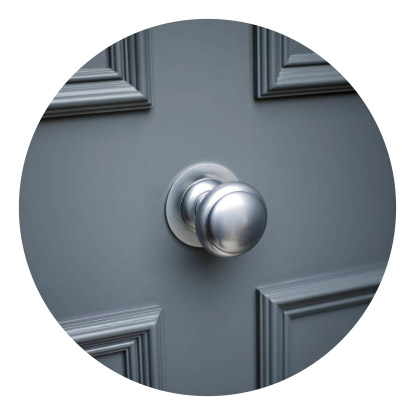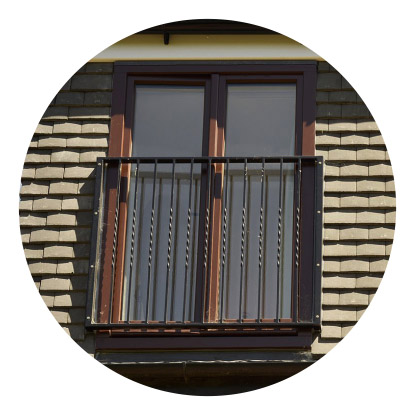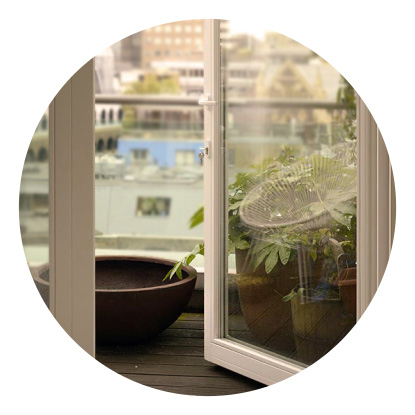HOW TO SOUNDPROOF A DOOR IN YOUR HOME
By learning how to soundproof a door yourself, and installing acoustic doors, you can return peace and quiet to any home.
In this guide you will find all you need to know about how to soundproof doors. From the reasons why noise is a problem and how to approach noise reduction, to how you can soundproof a door with household products. We hope it answers any questions you might have. If not, just get in touch and we’ll be happy to help! You can use the following menu to navigate to the most relevant section:
WHY YOU NEED TO SOUNDPROOF YOUR DOORS
Noise is a problem. A serious problem. In fact, it’s so huge that the World Health Organization estimates that we lose over 1 million years of healthy living per year due to it. So with your doors presenting the largest gap in your home’s structure, it stands to reason that it should take top priority when soundproofing your home.
NOISE AND YOUR HEALTH
What might just seem like innocent sounds can actually be quite sinister. Studies have found that exposure to road traffic noise considerably increases the risk of stroke in the over 65s. While for children, prolonged exposure has been proven to impair long term memory, reading and speech perception.
These are just two examples in a long list of the physical side effects from noise pollution, including stress, headaches, hypertension and anxiety. All of which can affect both your long and short term quality of life.
NOISE AND YOUR SLEEP
When noise strikes at night, there can be yet more serious consequences. You see, it’s not just good enough to get 8 hours in. You need uninterrupted, quality sleep to be at your best. This means passing soundly through your 120 minute sleep cycles without disturbance.
Unfortunately, noise pollution can easily shatter that cycle. While you’re asleep, your brain still processes the sounds around you. Sudden, loud noises can snap you out of your current stage of sleep and, although it may not wake you up fully, will disrupt your body’s regenerative processes.
Consistently poor sleep can lead to many mental and physical health problems. It can diminish your immune system, increase blood pressure and make you more prone to diabetes.
WHO guidelines suggest that to ensure a quality night’s sleep, noise in your bedroom should not exceed 30dB (LAeq,8h), and definitely should not exceed 45dB(LAmax, 8h at night 23:00-07:00 hrs). So you may really want to consider soundproofing bedroom doors in particular.
WHY YOUR DOORS ARE A PROBLEM
Let’s take a look at the structure of your home. You have (mostly) solid walls, a solid roof, and hopefully a solid ceiling and floor. All of these structural elements are designed to be strong and sturdy, which naturally makes them good noise insulators.
But then you have two weak links: your windows and doors. Your windows will comprise between 20-60% of your home’s external walls. And, as we outline in our guide on how to soundproof windows, are areas that sound can easily penetrate.
You may not think your doors are so much of an issue. You’ve just got your front and back doors to worry about, right? Wrong. Your internal doors can be a huge part of your noise pollution problem too.
When it comes to your external doors, noise will easily get through:
-
- Weak or non-existent seals
- A poor or missing threshold
- Your letter box
- Glazing within the door
- Slim wooden panelling (often 5-10mm)
- Gaps around the door frame
- Even the keyhole
Interior doors are even worse. In most properties these doors tend to be hollow core – basically two wooden panels that have been joined together – and have considerable gaps around the door. They will do barely anything to stop noise.
FILLING OPTIONS
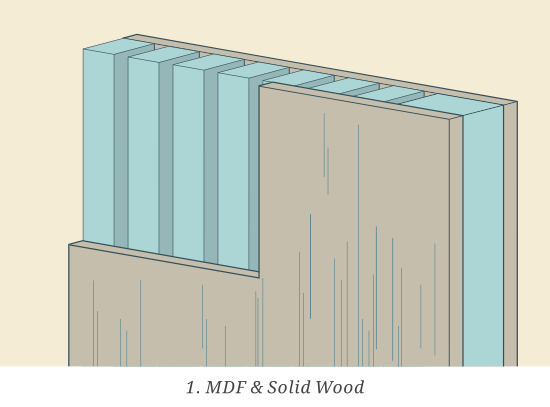
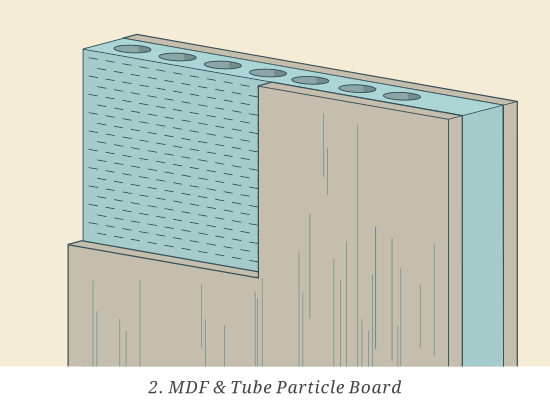
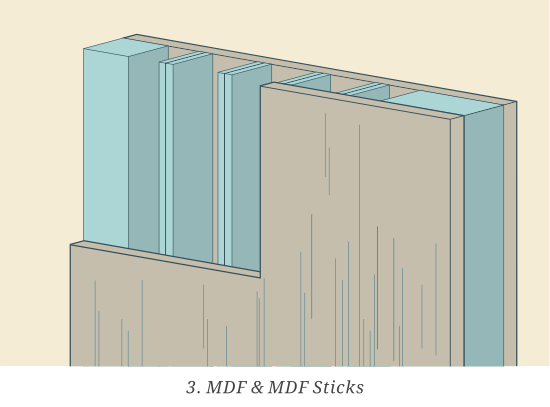
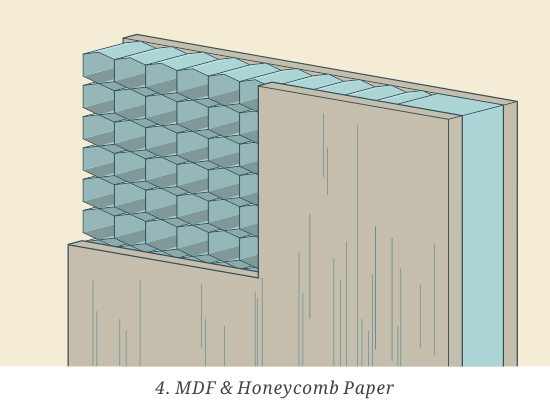
To understand this better, we need to take a look at some Rw values. These are simply how we assess the acoustical performance of doors and other materials. The lower the value, the worse the material is at blocking sound.
- Rw 25: normal speech is easily understood
- Rw 30: loud speech is easily understood
- Rw 35: loud speech is audible, but not understood
- Rw 40: loud speech is a murmur
- Rw 45: loud speech is almost inaudible
- Rw 50: loud sounds are very faint
Now let’s compare these to the typical elements of your home:
- Rw 15-20: an internal, hollow core door
- Rw 25-33: solid wood doors
- Rw 25-45: laminated acoustic glass doors (eg patio door)
- Rw 25-35: solid wood exterior doors
- Rw 42+: acoustic doors
Most homes will feature hollow core doors between rooms, and solid wood exterior doors. This means that sound insulation inside the typical home is very poor. And while exterior doors can perform well, any air gaps will considerably diminish their Rw value.
In Summary
- Noise is a serious problem, especially in the city.
- It can adversely affect your sleep and your mental health.
- It can also cause long-term health issues.
- Plus it might put you in your neighbours’ bad books.
- Your doors are the weakest point of your home.
- Your interior doors likely do nothing to stop sound.
- Your exterior doors may perform well, but can be easily compromised.
From soundproofing doors, to installing acoustic doors, there are various steps you can take to reduce noise in your home. But before we get to them, let’s take a look at the key principles of soundproofing a door.
THE KEY TO SOUNDPROOFING A DOOR
Sound travels through the path of least resistance. This means that when it comes to soundproofing a door, you are only as strong as your weakest link. To combat this problem, there are two key principles that all noise reduction products rely on.
INCREASING MASS
In really simple terms, the heavier and more dense a material is, the better it is at blocking noise. Standard glass and hollow doors are just too slim to stop sound from getting in. Whereas acoustic glass and heavy doors feature denser materials that dampen and dissipate sound waves.
CLOSING GAPS
Noise travels seamlessly through air. If there are any air gaps around your door, noise will easily enter/exit and undo any other soundproofing measures you may have taken. To effectively soundproof a door, the whole unit needs to be properly sealed. That means no gaps between the door and the frame and floor, or within the door unit itself.
In Summary
- Noise will travel the path of least resistance.
- If you have a weak point in your door, noise will find its way in/out.
- To effectively soundproof a door you need to increase mass and close air gaps.
- The acoustic performance of a door will depend on your ability to do both.
Now that we know why stopping noise is so important, and the key principles to soundproofing, let’s look at how to soundproof a door yourself.
HOW TO SOUNDPROOF A DOOR
To soundproof a door, we need to either increase the door’s mass or close any air gaps. Or – more than likely – do both. In the following guide, we will go into detail about how to soundproof doors yourself and give you an idea of the results you should expect.
You will use different techniques depending on the specific type of door that you’re looking to soundproof. So use the links below to jump to the solution that most suits you.
1. HOW TO SOUNDPROOF A FRONT DOOR
In this section we’re talking about how to soundproof a front door, but these techniques can be used on practically any hinged exterior door. As with all soundproofing techniques, there are two key principles that we are focusing on: increasing mass and closing gaps.
Some of these methods will be easy to implement with simple household items. Others will require some specialist products and a little DIY. To give you a better sense of what results you can expect, we have given indications of costs and noise reduction levels.
Do bear in mind that these solutions may not be effective by themselves. And you may need to use several of these methods to really reduce noise intrusion.
Now, let’s get started.
INSTALL AN ACOUSTIC DOOR SWEEP
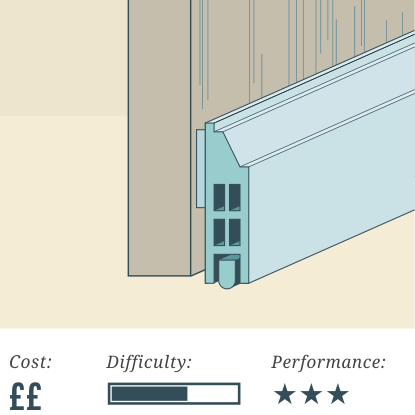
Also known as a soundproof door bottom, acoustic door sweeps are attached to the foot of the door. They work by closing the gap under your door. This tends to be the largest gap around your door frame.
Unlike standard draught excluders, acoustic door sweeps are made with acoustic materials and are specially designed to create a total barrier to the outside world. For this reason, they will likely brush against your floor as the door opens and closes. This might spell trouble if you like to place a door mat/rug inside your hall.
If you are installing an acoustic door sweep yourself, you will need a drill, a spirit level, screws and the sweep. Ensure that the area is clean before you begin. Be very careful to create total coverage and make certain that the sweep is installed level. Any small gaps will allow noise in.
If these are installed correctly, they can make a significant difference. Especially if you have a sizable gap under your door.
INSTALL SOUNDPROOF WEATHERSTRIPPING
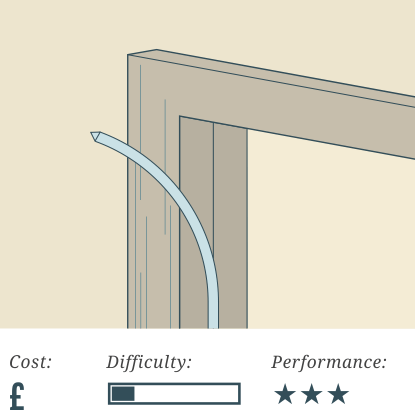
With the gap under your door dealt with, it’s time to plug up the rest of the gaps around the frame. The best way of achieving this is by installing soundproof weatherstripping in the door jambs. This is also known as acoustic ‘gaskets’, gasket seals or door insulation tape/foam.
Regardless, all of these products work on the same principle. Made from materials like neoprene, soundproof weatherstripping is designed to ensure there are no gaps around the frame once the door is closed. When the door is closed, the strips compress creating an airtight seal.
Installing soundproof weatherstripping/acoustic gaskets is extremely simple:
- Clean around the door frame using non-abrasive soap and warm water.
- Make sure the area is fully dry.
- Cut the weatherstripping/gaskets to the exact dimensions of your door jambs.
- Stick the strips down firmly.
- Make sure there are no gaps in the corners or folds that obstruct the door closing.
Make sure you buy good quality weatherstripping as cheaper products might not stick as well, rendering it ineffective.
USE ACOUSTIC CAULK
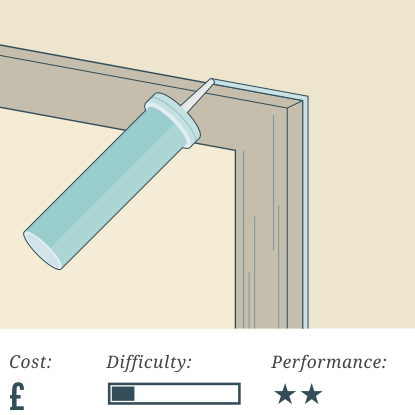
Acoustic caulk is a non-hardening sealant used to create a noise insulation barrier. It is installed around your door frame, between the frame and your walls. When it sets, it takes on a rubber-like consistency. It also prevents water from seeping into your structure.
Specifically designed to reduce sound transmission, acoustic caulk is inexpensive and easily installed.
To install acoustic caulk on your front door:
- Carefully remove any old caulk from your door frame.
- Use a clean cloth and non-abrasive soap to clean away any dirt or grime.
- Place masking tape around the installation area to prevent mess.
- Apply the caulk at a 45 degree angle slowly and evenly.
- Smooth the caulk using a butter knife or spoon.
- Remove the masking tape and leave the caulk to fully dry.
Once the caulk has dried, closely inspect the installation area. You should have a clean, single line of caulk running around the perimeter of your door frame. If you notice any gaps, or areas where the caulk has not adhered, it is best to start again.
Do note that this will improve noise reduction if you have gaps around your door frame. However, if your current door/caulk has been installed correctly you may not notice much of a difference.
USE ACOUSTIC EXPANDING FOAM
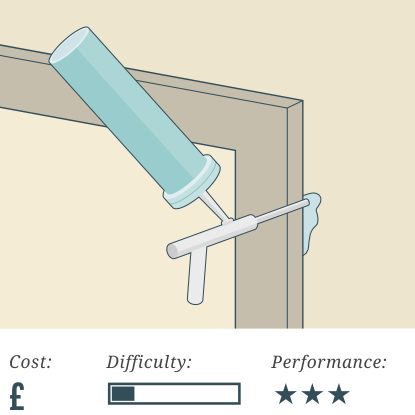
With the door frame sealed, the next thing you want to do is inspect the whole of the front door for any gaps or cracks. This includes the wall area around the door too.
In the event that you find a crack in the door, you can use a little acoustic expanding foam to plug the hole. This foam expands into gaps in materials and creates a hermetic seal.
- Locate the crack in the door/wall.
- Apply enough acoustic expanding foam to fill the gap.
- Wipe away any excess and leave to dry.
Most acoustic expanding foams are adhesive to a wide range of surfaces including timber, brick, concrete and PVC. Importantly, these foams are designed to be unreactive to the materials they are used on and can be plastered over and sanded.
It is recommended that you paint over/varnish the dried foam to prevent UV penetration and improve aesthetics.
INSTALL ACOUSTIC DOOR CURTAINS
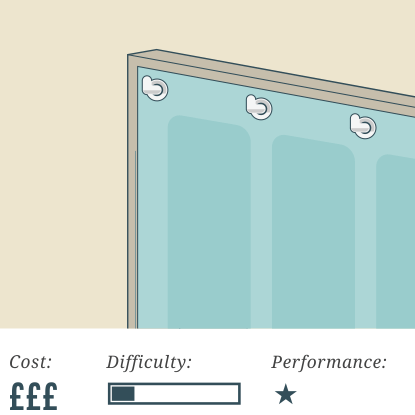
Once you have done everything you can with your front door, it’s time to think about your hallway.
One option you have is to install acoustic door curtains. These are curtains installed inside your door that are specially designed to reduce noise transmission.
Although many acoustic door curtains will come with claims to reduce noise, the reality is that they will do very little to prevent noise entering your property. This is because there will be air gaps all around the curtain. Instead, what they will do is reduce echo. This is beneficial in large, empty hallways and other rooms like home studios and cinemas where acoustic performance is important.
That said, there are some additional advantages to installing door curtains. They will block out light, improve thermal comfort and can be a good design option.
If you’re thinking about buying acoustic door curtains, consider the following:
- The thicker the curtain, the better. More mass means less noise.
- Take decibel reduction claims with a pinch of salt. If legitimate, they are produced in a laboratory. Real world applications will not be as effective.
- These curtains do more to improve sound quality than reduce noise.
In Summary
- Your front door can be a real weak point for noise.
- To make it more efficient at blocking noise, you need to add mass and close air gaps.
- To do so, there are many products available.
- These include acoustic door sweeps, gaskets and caulk.
- You can also add acoustic curtains and other materials to the door.
- It is unlikely that just one solution will work effectively.
- It is recommended that you combine some or all of the above for best results.
With the front door out of the way, let’s look at the most problematic internal door: the bedroom door.
2. HOW TO SOUNDPROOF A BEDROOM DOOR
When it comes to soundproofing bedroom doors, most of the options above apply. You should: install acoustic door sweeps, use weatherstripping techniques to create a better seal, fill gaps and cracks with acoustic expanding foams. If you do not do these things, the following suggestions are unlikely to improve the acoustic performance of your bedroom door.
As many bedroom doors are hollow core, you have a few other methods open to you. All of these rely on you adding more mass to the door. However, before you go steamrolling in, there are a couple of things to think about.
- Your door and its hinges may not be able to support much additional mass.
- Adding mass may prevent the door opening properly.
- You must ensure all air gaps are closed.
- You will not achieve the same level of noise reduction as you would with a solid or acoustic door.
With that out of the way, let’s take a look at what you can do.
INSTALL ADDITIONAL WOOD PANELS/DRYWALL

Traditionally used on ceilings and walls, acoustic plasterboard can be attached to your door to provide an added layer of noise reduction. This has a higher density than standard plasterboard.
To install you need to:
- Cut the board to the size of your door.
- Make sure there is space for the door handle.
- Attach with heavy duty adhesive/nails.
Now, if you do decide to do this you must be aware of a few things:
- Your door handles may not be able to support the weight of the board.
- Its acoustic effects will be minimal due to the fact that you cannot create complete coverage.
- Installation is not straightforward. The nails may not get much purchase in your door as it is hollow. This may also damage your door.
- Acoustic drywall can be expensive.
So, given those four points, why did we put this option up there? Well, if you’re searching online for ways to soundproof a bedroom door, you will find this option on most lists.
Unfortunately, a lot of these sites are designed to sell products, not to give you sound advice. Installing acoustic boards/wood to your hollow door is a bad option. It is difficult to install, will damage your door, and will produce minimal gains as perfect installation is near impossible.
INSTALL SOUNDPROOF BLANKETS

Another option is to install acoustic blankets to soundproof a bedroom door. They are often made from fiberglass, cotton and polyester mixes to combine noise reduction with a decent aesthetic and functionality.
Soundproof blankets are also known as sound absorptive blankets, which is actually a better way of understanding them. By their nature, the door blankets cannot create an airtight seal to prevent sound transmission. And they aren’t good at reflecting noise away. Instead, what they do is absorb sound, reducing its ability to echo and transfer.
Think screaming into a pillow instead of just, well, screaming.
For this reason, you should pay attention to the blanket’s absorption efficiency. This is known as its Noise Reduction Coefficient (NRC). A higher rating (closer to 1.0) means it is better at absorbing noise.
Installing a soundproof blanket on your bedroom door is really simple. You just need to drill the grommets into the wall above your door, then simply hang the blanket from these fittings. The closer the blanket is to the door, the better it will be at preventing noise from flanking.
If you’re thinking about installing soundproof blankets, here’s what you need to consider:
- These blankets work by absorbing noise.
- Pay close attention to their noise reduction coefficient (NRC).
- The thicker and denser the blanket, the better it tends to work.
- The closer the blanket is installed to the door, the better.
- Expect a reduction in noise of a few decibels.
- Blankets are only really recommended once you have treated the gaps around your door.
INSTALL MASS LOADED VINYL

Mass Loaded Vinyl (MLV) is what is known as a ‘limp mass barrier’. There are many different MLV products available, all of which are comprised of two main elements:
- a ‘limp’ and flexible vinyl; and,
- a dense, high mass material.
These are fused together to create a heavy, dense vinyl which reduces noise transmission. It works by absorbing and dissipating the soundwaves that hit it.
The easiest way to think about this is by imagining how a tennis ball would react when it hits a blanket hanging on a washing line. Instead of bouncing back, the ball will lose all of its energy and fall down flat, while the blanket will ripple slightly before returning to its original position.
With a mass loaded vinyl, the sound waves will hit the vinyl, causing it to ripple. Then, instead of passing through your door, the energy from the sound wave is converted into heat and kinetic energy which quickly dissipates.
So with that out of the way, does it work? In short, yes. But there are some considerations.
- For mass loaded vinyl to work optimally, it needs to hang limp.
- This means that it should not be affixed to your door, but instead hang in front of your door.
- Unfortunately, this is not practical in most situations as it will make entering/exiting the room difficult.
Many guides to soundproofing bedroom doors will suggest that you can attach the mass loaded vinyl to the door directly using adhesive or nails. This will work at reducing sound, but there are further things to bear in mind:
- The vinyl will not work optimally as it will not be flexible.
- It will add considerable weight, which a normal hollow frame door might not support.
- You will likely have to reinforce the door by adding another hinge and/or upgrading your screws.
- Attaching vinyl directly will likely damage the door.
- Install a 60 minute fire-rated door Rw 30-34db
In Summary
To soundproof a bedroom door you can:
- Install acoustic door sweeps to stop sound coming under the door.
- Add weatherstripping/gasket insulation to create a better seal around the door.
- Use expanding foams to plug up any gaps in the door/frame.
- Add additional mass to your doors using blankets or mass loaded vinyl.
- Attach plasterboard or wood panels to your door.
- For best results, it is recommended that you install a solid or acoustic door combined with better insulation.
So now you know how to soundproof doors yourself, let’s explore the ultimate solution: installing soundproof doors.
SOUNDPROOF DOORS
If noise is a serious concern, your best solution is to install soundproof doors. Also known as acoustic doors these units are specially designed to reduce noise. Many soundproof boast incredible reductions in noise of up to 50dB! In the following section we will explain how soundproof doors work, and what to consider when buying them.
HOW SOUNDPROOF DOORS WORK
Soundproof doors rely on the same key principles as any other soundproofing product:
- Increasing mass to dampen and dissipate soundwaves.
- Closing gaps to prevent noise getting around the door unit.
How exactly this is achieved will vary from product to product, but will likely be a combination of the following elements.
ACOUSTIC INSERTS
Most acoustic doors are not just solid wood. Instead, they contain acoustic inserts between timber cladding. This may not seem as appealing as, say, solid oak, but has superior noise insulation properties.
Acoustic inserts tend to be made of a dense fibre-plastic composite material.
TREATED THRESHOLDS
Manufactured in a wide range of materials, treated thresholds are designed to ensure the door closes flush. Preventing any air gaps forming under the door itself.
AUTOMATIC DOOR BOTTOMS
Automatic door bottoms are installed alongside treated thresholds, and are attached directly to the door.
A plunger inside the door bottom is activated when it comes into contact with the door frame upon closing. This causes the seal within the door bottom to be activated and compress into the threshold creating an airtight seal.
ACOUSTIC GASKETING
Installed around the door jambs and header, acoustic gasketing tends to be made from either silicone or neoprene. These materials compress when the door is closed to create a total seal.
SPECIALISED HINGES
Acoustic doors will use either Cam Hinges or concealed hinges. Cam hinges work by lifting the door as it opens, then dropping into a tight seal when closed.
Concealed hinges are hidden within the door itself. This enables the door to close completely flush to the frame and prevents air exposure.
ACOUSTIC MEETING STILES & ASTRAGALS
In double door systems, acoustic meeting stiles and astragals work by sealing gaps around the perimeter of the door. In particular, astragals create soundproof seals between the two edges of meeting doors.
ACOUSTIC GLAZING
In the case of soundproof glass doors, acoustic glazing is installed to prevent noise transference through the glass. This has far superior RW values of 35-50+dB.
INSULATING IRONMONGERY
Old style letterboxes, locks and handles tend to present huge air gaps. In a soundproof door system, these elements are designed to create effective seals while remaining highly functional.
In Summary
Soundproof doors work by combining the following elements::
- Acoustic inserts within the door structure.
- Specialised seals under and around the door.
- Concealed or CAM hinges.
- Acoustic meeting styles and astragals.
- Acoustic glazing.
- Insulating ironmongery.
Combined with professional installation, soundproof doors are the ultimate solution to noise pollution. And they often boast reductions of up to 50+dB!
SOUNDPROOF DOORS FAQS
ARE SOLID WOOD DOORS SOUNDPROOF?
Because they have more mass, solid wood doors are much better at stopping sound than hollow frame doors. However, if the door frame is not acoustically treated, noise will still get around a solid wood door.
HOW MUCH DO SOUNDPROOF DOORS COST?
The price will vary depending on the noise reduction level and type of door that you want. Our soundproof front doors start from £2,800.00. Our soundproof French doors start from £4,900.00.
ARE STEEL DOORS SOUNDPROOF?
There are many steel soundproof doors available on the market that provide really good levels of noise reduction. However, they are best suited to commercial installation, not homes.
CAN GLASS DOORS BE SOUNDPROOF?
Just like windows, glass doors can also be soundproof. You can add mass to the glass to make it more effective, such as lamination and glass inserts. And you can seal any cracks around the door itself to prevent noise getting in.
Other options include replacing old glass with acoustic glazing, but, as this is heavier, your door may not support it. Alternatively, there are specialist soundproof glass doors available that provide exemplary levels of noise reduction.
ARE FIRE DOORS SOUNDPROOF?
It is not strictly true that fire doors are soundproof. However, they are much more soundproof than your average door. This is because they are heavier and denser than standard doors. This prevents them burning quickly, but also means that sound can’t get through them easily. Additionally, they will be well insulated and have better seals, which prevents noise flanking around the frame.
HOW MUCH NOISE COMES THROUGH MY DOORS?
The level of noise that comes through your door varies depending on what type of door it is, and how well it is insulated. A typical internal door will have an RW value of 15-20dB. This means a normal conversation can be easily heard on the other side. A typical solid wood door has a value of between 25-35dB, which means a loud conversation will be audible, but not understandable.
BUY SOUNDPROOF DOORS
Heard enough? Come and see our Soundproof Doors
BEAUTIFUL & BESPOKE
By stocking products manufactured with the finest quality hard and softwoods, all of our soundproof windows and doors come with up to 10 years guarantee. Safeguarded against swelling and disease, they’re built just for you.
DOWNLOAD OUR BROCHURE
SPECIALIST SOUNDPROOF DOORS
Through specialist manufacturing and precision technology, we are offering you the best products available on the market. Don’t compromise on quality. Don’t compromise on design.
10 YEAR INSURANCE BACKED GUARANTEE
All of our products come with up to a 10 Year Insurance Backed Guarantee provided by the Consumer Protection Association. So you can rest assured that your home is in safe hands.
We have been Trading Standards Approved and are proud to be enrolled on the Buy With Confidence Scheme, ensuring customers just like you have their interests protected.
TRUSTMARK REGISTERED FOR QUALITY
Consumers can feel confident using a TrustMark registered business, as the government-endorsed scheme ensures high quality service and a range of consumer protection options.
AWARD-WINNING PRODUCTS & INSTALLATION
Following awards in 2020, and 2021, The Soundproof Windows was announced as the ‘Best Acoustic Window & Door Installation Company – London’ at the SME News Awards 2022.
